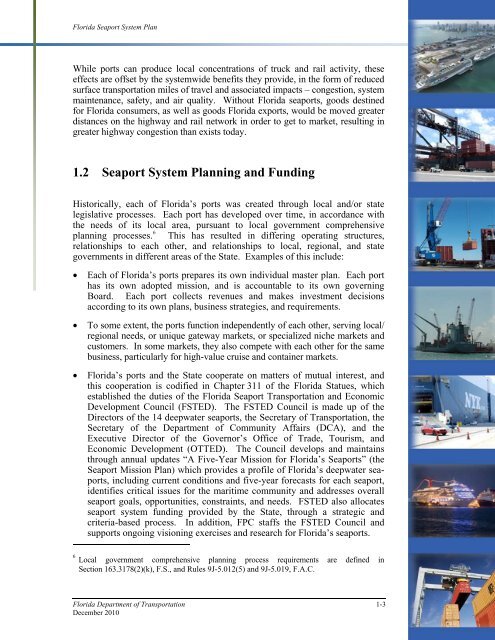Florida Seaport System Plan - SeaCIP
Florida Seaport System Plan - SeaCIP
Florida Seaport System Plan - SeaCIP
Create successful ePaper yourself
Turn your PDF publications into a flip-book with our unique Google optimized e-Paper software.
<strong>Florida</strong> <strong>Seaport</strong> <strong>System</strong> <strong>Plan</strong><br />
While ports can produce local concentrations of truck and rail activity, these<br />
effects are offset by the systemwide benefits they provide, in the form of reduced<br />
surface transportation miles of travel and associated impacts – congestion, system<br />
maintenance, safety, and air quality. Without <strong>Florida</strong> seaports, goods destined<br />
for <strong>Florida</strong> consumers, as well as goods <strong>Florida</strong> exports, would be moved greater<br />
distances on the highway and rail network in order to get to market, resulting in<br />
greater highway congestion than exists today.<br />
1.2 <strong>Seaport</strong> <strong>System</strong> <strong>Plan</strong>ning and Funding<br />
Historically, each of <strong>Florida</strong>’s ports was created through local and/or state<br />
legislative processes. Each port has developed over time, in accordance with<br />
the needs of its local area, pursuant to local government comprehensive<br />
planning processes. 6<br />
This has resulted in differing operating structures,<br />
relationships to each other, and relationships to local, regional, and state<br />
governments in different areas of the State. Examples of this include:<br />
• Each of <strong>Florida</strong>’s ports prepares its own individual master plan. Each port<br />
has its own adopted mission, and is accountable to its own governing<br />
Board. Each port collects revenues and makes investment decisions<br />
according to its own plans, business strategies, and requirements.<br />
• To some extent, the ports function independently of each other, serving local/<br />
regional needs, or unique gateway markets, or specialized niche markets and<br />
customers. In some markets, they also compete with each other for the same<br />
business, particularly for high-value cruise and container markets.<br />
• <strong>Florida</strong>’s ports and the State cooperate on matters of mutual interest, and<br />
this cooperation is codified in Chapter 311 of the <strong>Florida</strong> Statues, which<br />
established the duties of the <strong>Florida</strong> <strong>Seaport</strong> Transportation and Economic<br />
Development Council (FSTED). The FSTED Council is made up of the<br />
Directors of the 14 deepwater seaports, the Secretary of Transportation, the<br />
Secretary of the Department of Community Affairs (DCA), and the<br />
Executive Director of the Governor’s Office of Trade, Tourism, and<br />
Economic Development (OTTED). The Council develops and maintains<br />
through annual updates “A Five-Year Mission for <strong>Florida</strong>’s <strong>Seaport</strong>s” (the<br />
<strong>Seaport</strong> Mission <strong>Plan</strong>) which provides a profile of <strong>Florida</strong>’s deepwater seaports,<br />
including current conditions and five-year forecasts for each seaport,<br />
identifies critical issues for the maritime community and addresses overall<br />
seaport goals, opportunities, constraints, and needs. FSTED also allocates<br />
seaport system funding provided by the State, through a strategic and<br />
criteria-based process. In addition, FPC staffs the FSTED Council and<br />
supports ongoing visioning exercises and research for <strong>Florida</strong>’s seaports.<br />
6<br />
Local government comprehensive planning process requirements are defined in<br />
Section 163.3178(2)(k), F.S., and Rules 9J-5.012(5) and 9J-5.019, F.A.C.<br />
<strong>Florida</strong> Department of Transportation 1-3<br />
December 2010
















